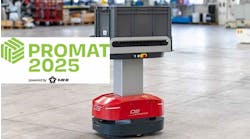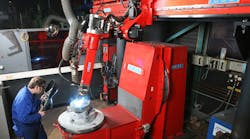Editor's Note: The REIS ROBOTICS SafetyController is no longer available.
Complicated welding tasks like automated build-up welding of worn-out forging tools require the presence of an operator in the welding cell of a robot. With the Reis Robotics SafetyController, those tasks can be checked and controlled by the operator without danger, so the welding cell has the precision of a robot-supported process with the proficiency and expertise that an operator provides.
Damaged dies must be repaired if die costs are to be kept low and service life high. Compared with manual build-up welding, even for complex weld geometries, perfect end faces can be manufactured with the help of the robot. Comparable, constant, concentric circles can hardly be achieved by an operator manually: processes like that often take hours so operators without the support of a robot are physically extremely stressed by unfavorable body posture, the intense radiation of UV light, welding smoke, and heat.
Though the parts to be repaired by the robot are often unique and differ in wear and damage, treating every workpiece individually is possible with the support of the flexible robot control ROBOTstar. Due to the varying wear conditions, an operator must be assigned to position the torch and workpiece to each other: the SafeProduction system offers an alternative.
IntegratedSafety, the freely programmable safety PLC for the protection of persons in the robot work envelope, directly operates within the SafetyController to permanently monitor the correct functioning of the robot and its control. The axis positions are detected in two channels. If there are deviations from the nominal value, there will be an automatic fast switch-off. Also, the robot moves at a reduced speed of only 10 in/s (250 mm/s) at the tool flange when an operator is present in the welding cell. Thus, the operator can enter the work envelope at any time without danger to watch the progress of the process. The operator is able to stop the robot at any time via an emergency switch-off.
The required weld geometries are programmed with Reis RobOffice and simulated using the simulation software Reis ProSim. During operation, the operator has the ability to adjust the weld parameters.
The system is not only more efficient for preparing repairs for complex workpieces but also improves the working conditions for the operators on-site without exposing them to the danger of injury by the robots. In typical systems, the robot takes over up to 70% of the work previously executed manually.
Visit www.reisrobotics.com











